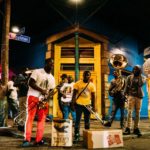New Orleans Plantation Tours: The Horrible and the Honest

When my sister and her boyfriend visited me in Louisiana, we knew we wanted to take part in one of the New Orleans plantation tours. My friend had already visited the Oak Alley Plantation, and her pictures looked pretty spectacular. It certainly was, but, we realized, not for the right reasons. Imagine a tour of a concentration camp where the overwhelming focus was on the lives of the Nazis, and where the guides wore Nazi uniforms. This should give you an idea as to how inappropriate the majority of the plantation tours in the South are.
The tour guides at Oak Alley Plantation were dressed in traditional clothes, with the intention of looking like slave owners. During the tour, the only information we were given was about the slave owners, while the only information we could find about slaves was on placards outside. My family and I definitely felt like this was not sufficient. Apparently, the majority of other plantation tours in the South are run like this as well. People are even able to get married at plantations, which to me, seems very strange, as these were places where human beings were abused and tortured.
New Orleans Plantation Tours: The Horrible and the Honest
When my parents and brother visited, we decided to check out a plantation tour, which emphasizes the lives of the slaves. We signed up for a tour at the Whitney Plantation, which just opened last year. We were disgusted to learn that it is the only plantation in Louisiana that focuses on the slaves.
When we arrived at the Whitney Plantation, it was incredibly hot and we covered ourselves in sun cream. After about ten minutes, the heavens opened and we were completely drenched. All we could think about was how difficult these weather conditions would have been for the slaves who worked from dawn until dusk.
Imagine a tour of a concentration camp where the overwhelming focus was on the lives of the Nazis, and where the guides wore Nazi uniforms.
At the entrance of the museum, there was an image of Ile de Goree in Senegal, where many slaves were transported overseas to plantations such as the Whitney. I did my gap year in Senegal and visited Ile de Goree several times, so it was incredible to have seen both sides of this horrific historical journey.
Our tour guide at the Whitney was extremely knowledgeable and told us exactly how the conditions were for the slaves. We were each given a lanyard with the image of a child slave, information about them that included how old they would have been today. Around the museum there were sculptures of these children created by the artist, Woodrow Nash, which were very moving.
Our tour guide took us around memorial spaces, then to the slaves’ quarters, and lastly, to the Big House. We entered the Big House through the back door, as the slaves would have done. Our guide informed us that culinary students from Dillard University visited the plantation and cooked in the kitchen there, using the same methods that the slaves would have done, so they could experience what it would have been like.
New Orleans Plantation Tours: The Horrible and the Honest
On the Louisiana Travel website, they discuss why bonfires are held as a tradition on Christmas Eve along the levees – supposedly lighting the way for Father Christmas. The website states, “Some historians believe they are a carry-down of an ancient European tradition where bonfires initially honored successful harvests and later from Christianity (south Louisiana was originally a French colony, and residents remain predominantly Catholic).”


People are even able to get married at plantations, which to me, seems very strange, as these were places where human beings were abused and tortured.
However, our tour guide rolled her eyes at this misconception, claiming that the tradition definitely originated from slavery. Before the time of year when slaves most commonly tried to escape the plantation, plantation owners would have lit their route so that they could have been seen and captured more easily. In addition, the fires would have deterred and intimidated slaves who wanted to escape. This burning across the levees has now been transformed into a twisted Christmas tradition.
When slaves were caught after trying to escape, they were branded on their forehead or cheeks with a fleur de lis, the symbol of New Orleans, and of Louisiana. This would mark them as troublemakers.
The museum is undergoing lots of developments and there are plans to create others like it in the South. I hope to return in a few years and see how it has progressed.
Photos for New Orleans Plantation Tours: The Horrible and the Honest by Ciara Cohen-Ennis and top photo by Unsplash.









Nancy Griffin Johnson is missing the point of this article entirely! She speaks with the knowledge of someone who has been living for 300 years, what a joke! Anyone who introduces themselves as a Cacausiam Cajun is a damn joke! Thank you for the informative and eye opening glimpse into just how ignorant people still are Ciara!
Roy